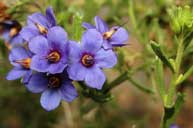In Flower This Week
A weekly news sheet prepared by a Gardens' volunteer.
Numbers before each plant refer to temporary IFTW labels in the gardens.
Numbers in square brackets [ ] refer to garden bed Sections. Plants in flower are in bold type.
View past issues of 'In Flower This Week'.
5 February 2014
Halgania cyanea click for larger image |
We will start our walk today from the café and follow the Main Path, finishing near the Rock Garden.
- After you leave the cafe on the left there is a Lilly Pilly or Syzygium sp. [Section 131], a tall shrub with very shiny leaves and powderpuff white flowers. The edible fruit matures from December to February, being a pear-shaped red or purple berry known as a Riberry.
- Further on your right is Correa ‘Canberra Bells’ [Section 240], a low spreading bush with red bell flowers with white tips. This plant was bred by local plant breeder Peter Ollerenshaw to mark the Centenary of Canberra in 2013.
- As you turn up the hill to your left look up to the right to see the deep red flowers of Callistemon viminalis [Section 310], also called Weeping Bottlebrush. It is a small tree with weeping foliage, which often grows along watercourses.
- On your left is Melaleuca lanceolata subsp. lanceolata [Section 10] with white fluffy flowers on an airy bush with fine needle-like foliage.
- A Callistemon sp. [Section 10], also on your left, is a small tree with pink brush-like flowers with gold tips.
- Look down on your right to see Grevillea ‘Bronze Rambler’ [Section 30], which is a popular low groundcover with divided foliage and red toothbrush flowers. Grevillea 'Bronze Rambler' originated in cultivation in the garden of W. and L.Wilson, Moe South, Victoria. It is said to be a cross between Grevillea rivularis and G. 'Poorinda Peter'.
- Grevillea ‘Poorinda Adorning’[Section 27] on your right is a low, prickly groundcover with bright red flowers with long styles. The female part of the flower, called a pistil, has three parts: stigma, style, and ovary. The style is a long tube-like structure that leads to the ovary. The Poorinda Grevillea cultivars were developed by Leo Hodge at his property ‘Poorinda’ near Buchan, Victoria.
- On your right after crossing the road is Grevillea ‘LadyO’[Section 24], a long‑blooming shrub with red flowers and bright green foliage. ‘LadyO’ is a cross between a Grevillea victoriae hybrid and G. rhyolitica. This cross was made by Peter Ollerenshaw (see also plant #2) and named for his mother.
- On your left Crowea exalata [Section 112] forms a mounded bush of fine foliage dotted with pink star flowers. Croweas are neat long-blooming additions to any garden.
- As you enter the Sydney Gully Region, on your left is Dampiera purpurea [Section 191h], a low bush with purple flowers with white centres.
- On the left are several bushes of Platysace lanceolata [Section 191e] with white terminal clusters of flowers on an open bush.
- Banksia serrata [Section 191e] also on the left is a small tree with very large greenish flowerheads, serrated leaves and a wrinkled trunk. The trunk wrinkles more with age leading to its common name of Old Man Banksia.
- Diverge here from the Main Path and bear right along the edge of the Rock Garden. Calytrix leschenaultii [Section 14] is a delicate plant with pale mauve flowers with yellow centres.
- On the right is Halgania cyanea [Section 14] with bright blue flowers with dark centres on a tiny bush.
- Eremophila ionantha [Section 14] from SW Western Australia is a small bush with narrow silvery-green leaves and mauve bell flowers. “Ionantha” is derived from the Greek words for violet-coloured flowers. This shrub is known for its longevity and some plants in cultivation are over 40 years old.
Rosalind Walcott
![Director of National Parks [logo]](../../../../images/dnp_90px.gif)







